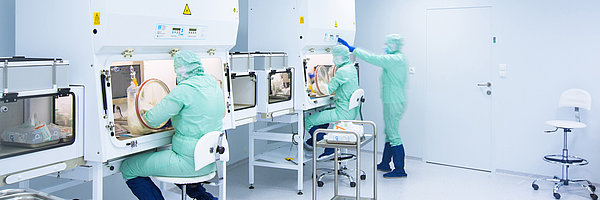The term GxP covers all guidelines for good working practice that are particularly relevant in the healthcare industry. The "x" in the middle stands for the abbreviation of the respective work area and is explained in more detail below. With our extensive industry experience, we can help you implement the most important GxP guidelines and support a fast and smooth implementation.
Good Manufacturing Practice (GMP)
GMP stands for "good manufacturing practice". These are guidelines for quality assurance in production processes and the production environment during the manufacture of medicinal products, active ingredients, cosmetics, food, and feed. The GMP requirements are divided into Part 1 and Part 2 and include corresponding annexes. A quality-oriented management system that complies with the GMP standards ensures a product quality that meets the binding specifications of the health authorities and thus enables market access.
There are various organisations and authorities that have developed corresponding GMP guidelines. These include, for example, the European Commission, the Pharmaceutical Inspection Co-Operation Scheme (PIC/S), the US Food and Drug Administration (FDA) and the International Council for Harmonisation of Technical Requirements for Pharmaceuticals for Human Use (ICH). The FDA first introduced the term "Good Manufacturing Practice" in 1962 as part of the so-called "current good manufacturing practice initiative".
Good Distribution Practice (GDP)
GDP stands for "Good Distribution Practice of medicinal products for human use". The aim of GDP is to ensure that fake medicines do not enter legal supply chains. It does this by controlling the entire supply chain to ensure the quality and integrity of medicines. The guidelines were put into force by the European Commission on 07.09.2013. The former directive for "Good Storage Practice" (GSP) is now an integral part of GDP.
The basis for GDP is Directive 2001/83/EC of the European Parliament, in particular Articles 84 and 85b (3). In Germany, these requirements are implemented in § 1a "Quality Assurance System of the Pharmaceutical Trade Ordinance" (AM-HandelsV). It is explicitly pointed out that the EU guidelines for the "Good Distribution Practice of Medicinal Products" must also be observed in Germany.
Good Laboratory Practice (GLP)
GLP stands for "good laboratory practice" and defines the organisational procedures and conditions under which tests are planned, carried out and monitored in laboratories. It serves as a framework for conducting safety tests on chemicals, pharmaceuticals, plant protection products, food additives and explosives, as required by law in many countries. It also covers the recording and reporting of the tests performed.
Studies conducted in accordance with GLP regulations that receive a Klimisch score of 1 are considered reliable and of high quality. Internationally, GLP is coordinated by the Organisation for Economic Co-operation and Development (OECD) and serves as a guide for various countries. At national level, GLP is represented by the German Federal Agency for Good Laboratory Practice, located at the Federal Institute for Risk Assessment. The EC Directives and the German Chemicals Act form the legal basis for GLP. According to the REACH (Registration, Evaluation, Authorisation and Restriction of Chemicals) EU Chemicals Regulation, all new tests for data collection must be carried out within the framework of GLP.


